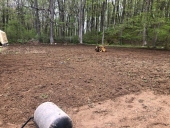posted 7 years ago
Hi Carson!
Can you tell us your approximate location on the globe? Knowing that may help us offer the best advice. I’ll offer my thoughts on your grasses and land. I’m in a somewhat similar situation as my wife and I just bought some land last year that had cows on it for 20 years, but the cows had free reign over the land and no rotational grazing was done, so the cows eat their favorite things and what they find less palatable grows unchecked. My neighbor who owned the cows did mow once or twice a year to keep things like saplings and wild blackberries and other briars from getting a foothold. There are now no grazing animals on my new farm, but I want to put cows back on in two or three years. After I did a soil test and limed the land I’m letting everything there grow and I’m making observations on what’s growing. I have some different cool season grasses, some desirable forbs like clovers and vetch, and also some undesirable weeds like thistle. Come August I'll be making notes of how the pastures have changes and what kinds of warm season grasses are growing and what kinds of weeds are present during that time.
My plan right now this spring is I’m letting all the cool season grasses and clovers go to seed, which they have already done, and then mow the place in the next few weeks or up to mid June. I’ve been manually knocking back the thistles, to keep them from going to flower. It a slight chore, but there are only a few hundred thistles scattered about, not thousands, so it’s manageable but just takes time. If those go unchecked I will have thousands of thistles, and that’s exactly what I don’t want.
I think the trick to mowing is timing. Letting everything go to seed may mean some undesirable weeds keep proliferating. Try to identify what sort of other plants are growing besides grasses/fescues, and find out if some of those are invasive and will make problems worse if they’re allowed to go to seed, or if some are undesireable as forage for grazing livestock.
If your land were mine, I would err on the side of caution and mow to keep things in check. Mowing is not going to hurt the grasses, they’re prolific and relentless. And one more note, if you haven’t done a soil test, I recommend sending some soil samples to a lab for analysis. Something as simple as adjusting the soils pH with lime can really help encourage grasses and a lot of weeds that love acidic soils can find the less acidic conditions undesirable.
"Study books and observe nature; if they do not agree, throw away the books." ~ William A. Albrecht










